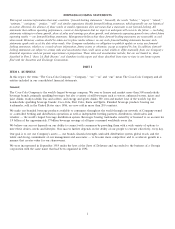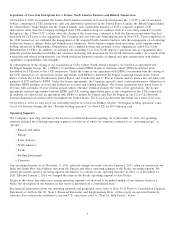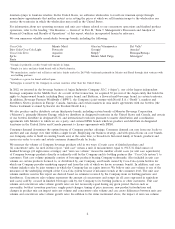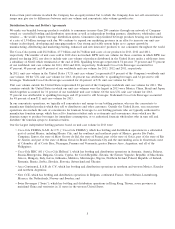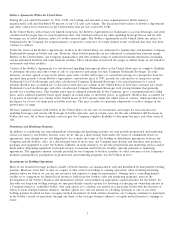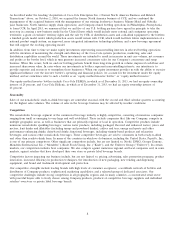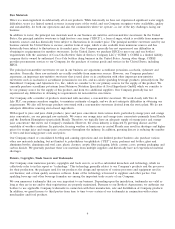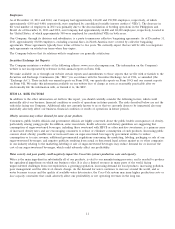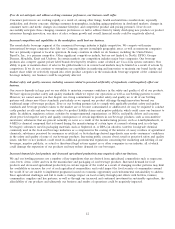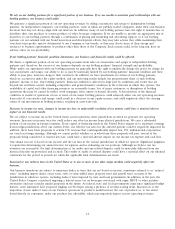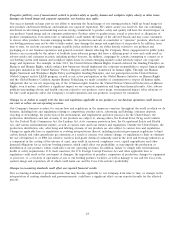Coca Cola 2013 Annual Report Download - page 10
Download and view the complete annual report
Please find page 10 of the 2013 Coca Cola annual report below. You can navigate through the pages in the report by either clicking on the pages listed below, or by using the keyword search tool below to find specific information within the annual report.As described under the heading ‘‘Acquisition of Coca-Cola Enterprises Inc.’s Former North America Business and Related
Transactions’’ above, on October 2, 2010, we acquired the former North America business of CCE, and we combined the
management of the acquired business with the management of our existing foodservice business; Minute Maid and Odwalla
juice businesses; North America supply chain operations; and Company-owned bottling operations in Philadelphia, Pennsylvania,
to form CCR. In April 2013, we announced that we and five of our U.S. bottling partners have agreed in principle to take the
next step in creating a new business model in the United States which would include more rational and contiguous operating
territories; a grant of exclusive territory rights and the sale by CCR of distribution assets and cold-drink equipment to the bottlers;
a finished goods model under which production assets would remain with CCR, which would facilitate future implementation of a
national product supply system; an improved, more integrated information technology platform; and a new beverage agreement
that will support the evolving operating model.
In addition, from time to time we make equity investments representing noncontrolling interests in selected bottling operations
with the intention of maximizing the strength and efficiency of the Coca-Cola system’s production, marketing, sales and
distribution capabilities around the world. These investments are intended to result in increases in unit case volume, net revenues
and profits at the bottler level, which in turn generate increased concentrate sales for our Company’s concentrate and syrup
business. When this occurs, both we and our bottling partners benefit from long-term growth in volume, improved cash flows and
increased shareowner value. In cases where our investments in bottlers represent noncontrolling interests, our intention is to
provide expertise and resources to strengthen those businesses. When our equity investment provides us with the ability to exercise
significant influence over the investee bottler’s operating and financial policies, we account for the investment under the equity
method, and we sometimes refer to such a bottler as an ‘‘equity method investee bottler’’ or ‘‘equity method investee.’’
Our equity method investee bottlers include Coca-Cola FEMSA, in which as of December 31, 2013, we had an equity ownership
interest of 28 percent, and Coca-Cola Hellenic, in which as of December 31, 2013, we had an equity ownership interest of
23 percent.
Seasonality
Sales of our nonalcoholic ready-to-drink beverages are somewhat seasonal, with the second and third calendar quarters accounting
for the highest sales volumes. The volume of sales in the beverage business may be affected by weather conditions.
Competition
The nonalcoholic beverage segment of the commercial beverage industry is highly competitive, consisting of numerous companies
ranging from small or emerging to very large and well established. These include companies that, like our Company, compete in
multiple geographic areas, as well as businesses that are primarily regional or local in operation. Competitive products include
numerous nonalcoholic sparkling beverages; various water products, including packaged, flavored and enhanced waters; juices and
nectars; fruit drinks and dilutables (including syrups and powdered drinks); coffees and teas; energy and sports and other
performance-enhancing drinks; dairy-based drinks; functional beverages, including vitamin-based products and relaxation
beverages; and various other nonalcoholic beverages. These competitive beverages are sold to consumers in both ready-to-drink
and other than ready-to-drink form. In many of the countries in which we do business, including the United States, PepsiCo, Inc.,
is one of our primary competitors. Other significant competitors include, but are not limited to, Nestl´
e, DPSG, Groupe Danone,
Mondelez International, Inc. (‘‘Mondelez’’), Kraft Foods Group, Inc. (‘‘Kraft’’), and the Unilever Group (‘‘Unilever’’). In certain
markets, our competition includes beer companies. We also compete against numerous regional and local companies and, in some
markets, against retailers that have developed their own store or private label beverage brands.
Competitive factors impacting our business include, but are not limited to, pricing, advertising, sales promotion programs, product
innovation, increased efficiency in production techniques, the introduction of new packaging, new vending and dispensing
equipment, and brand and trademark development and protection.
Our competitive strengths include leading brands with high levels of consumer acceptance; a worldwide network of bottlers and
distributors of Company products; sophisticated marketing capabilities; and a talented group of dedicated associates. Our
competitive challenges include strong competition in all geographic regions and, in many countries, a concentrated retail sector
with powerful buyers able to freely choose among Company products, products of competitive beverage suppliers and individual
retailers’ own store or private label beverage brands.
8



